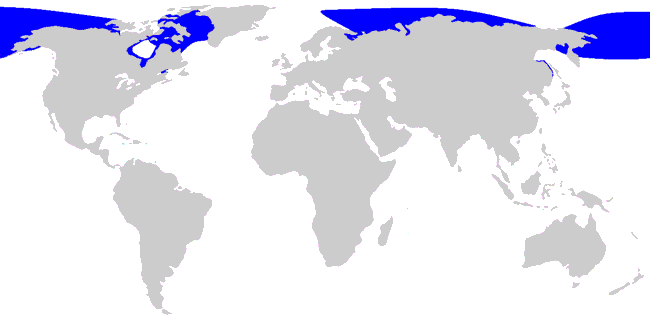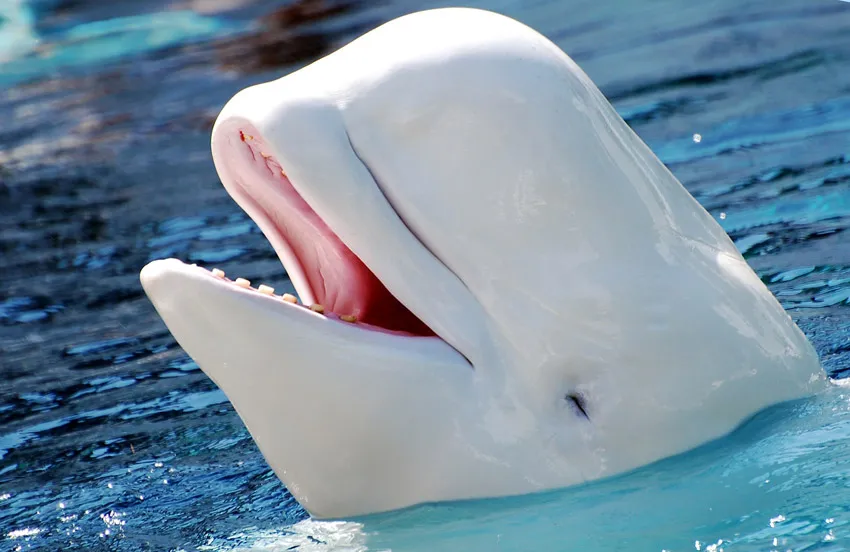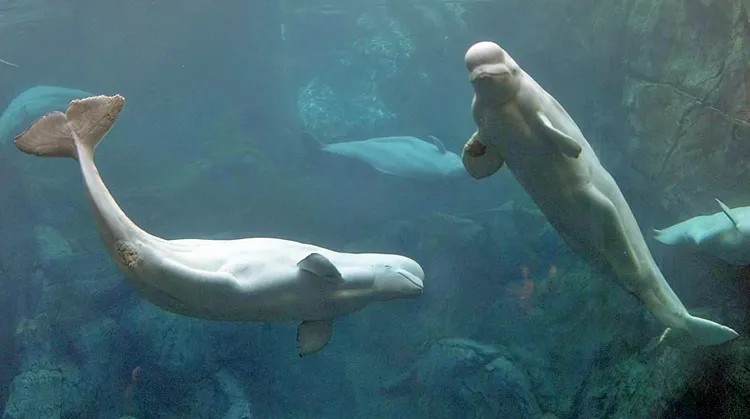Beluga Whale / White Whale - Facts and Adaptations
Delphinapterus leucas
The only all white whales, belugas are small and highly social, living in fluid travelling groups that can become quite large at certain times of the year. They have a variety of facial expressions and can be musically vocal earning them the name of "canary of the sea".
beluga whale facts Basics
Weight: up to 1,600kg, from 600kg for
adults, males are about 25% larger than females.
Average Length: 2.5 to 6 m long (8.5 -
20 feet)
Reproduction: The breeding
s is from February to May, it is thought that belugas have
delayed implantation of a few weeks or months, where the
development of a fertilized egg is paused according to environmental
conditions so that birth occurs at a more favourable time.
The length of gestation is not fully known but thought to
be over a year, between 12 and possibly up to 15 months.
The calves are born between March and September depending
on the location, generally over a month or two at any one
particular place. Belugas are born dark grey and become
paler as they get older becoming white by the time they
reach sexual maturity at about 8 years old.
Estimated world population: 200,000 individuals
Feeding & diet: Belugas are diverse
feeders, their preferred prey depends on the location of
a population though is generally fish such as salmon, herring
and arctic cod, they also feed on a variety of other available
marine prey such as squid, octopus, shrimps and crabs.
Conservation status: Least concern,
it is thought there are some large but uncounted subpopulations,
while others may be endangered locally.
Distribution:
Circumpolar around much of the Arctic, sometimes individuals
are found down to more temperate northern latitudes.
Predators: Polar bears and Orcas (killer
whales) predate on belugas across their whole Arctic range.

Distribution range of the beluga
whale
What are Belugas like? how do they survive?
Belugas are striking looking toothed small whales, they have the ability to move their heads independently of their body unlike other whales which along with the ability to move their face into a variety of expressions makes them seem more human and relatable than many other marine mammals. There is a bump at the front of the head called the melon which is involved in making and projecting sounds and in echolocation.
Belugas like company and form groups called pods of around 10 individuals on average with a range of 2 to 25, though during the summer months they can form groups of hundreds or thousands in shallow waters such as estuaries and coastal areas. Different groups behave differently in terms of being migratory depending on where they live, some will travel over large distances from summer to winter whereas others do not migrate far at all. The smaller groups may have related members, though they are quite fluid and individuals may join or leave one group for another on a fairly regular basis, generally males will travel together in a group while females with their offspring form their own groups.
Like many social animals, belugas are enthusiastic vocal communicators making a variety of sounds from whistles and chirps to clicks, clangs and squeals that can sometimes be heard above the water even when on a small boat. They are able to imitate sounds they hear around them including human speech.

Beluga Whale Adaptations:
 Beluga whales have a set of particular
anatomical, behavioural and physiological adaptations that allow
them to survive successfully.
Beluga whales have a set of particular
anatomical, behavioural and physiological adaptations that allow
them to survive successfully.
- Extensive range of vocalizations (anatomical
and behavioural) - Belugas have the anatomical structures
to be able to make a wide range of vocal sounds, unlike
humans with our vocal cords, belugas produce these sounds
in the nasal sacs near the blowhole but like humans some
of them can be modified by the shape of the lips under the
control of a series of small muscles. There is a variety
of reasons for these sounds, communicating with other whales
in the pod and in the vicinity is important, but they are
also used for echolocation. The melon at the front of the
head focuses a series of clicks into a beam projecting forwards
from the whale where they bounce off objects, the echoes
being interpreted by the whale. In this manner whales can
find their way about in water and also find holes in sea-ice
for breathing or even pockets of trapped air under the ice
that can also be used.
The sounds made by different populations of belugas are more different the further away the animals live, so beluga populations have accents in a similar way to identified amongst other animals such as birds. - No dorsal fin, but an elongated dorsal ridge
(anatomical) - Most whales have a dorsal fin (in the middle
of the back) which helps them maintain a steady line when
swimming, belugas don't have this fin, but instead have
a hardened long dorsal ridge. The lack of fin is an adaptation
to swimming under sea-ice when it might get caught or damaged,
the ridge performs a similar job and is also used with the
head for pushing up against ice to break through.
- Live in groups of various sizes (behavioural)
- Belugas spend their lives living in groups, typically
of about 10 individuals, generally between 2 and 25 and
sometimes up to hundreds or even thousands, there are a
number of advantages to group living. Groups of any size
help them avoid predators by confusing the predators when
they attack so making a kill less likely and by providing
more animals that may spot and alert the group to those
predators sooner rather than later.
Co-operative hunting, belugas generally live in shallow coastal waters feeding at depths of 20m (66ft) and less, several animals can herd prey into a tighter area where they can be more successfully isolated and attacked.
Keeping open breathing holes or polynyas. If belugas don't move south soon enough in the winter, they may be trapped by sea ice. Their constant movement and surfacing can help to keep these holes open for longer than if the water was calm, this is more readily accomplished with many whales, so working together in this way they have a better chance of survival than they would alone. - Low surface area to volume ratio (anatomical)
- Like all marine mammals that live in icy waters, belugas
are large animals, even though they are relatively small
for whales and large size makes it easier to stay warm by
retaining metabolic heat, belugas have a clean shape with
only the flippers adding much extra surface area.
- Countercurrent heat exchanger in the flippers
and flukes ((anatomical and physiological) - Arteries
in the flippers and flukes taking blood in are surrounded
with veins taking blood out, so that warm blood entering
is cooled down by the cold blood leaving. In this way warmth
is retained rather than being lost because of the high surface
area - low volume of the flipper. In other circumstances
blood flow to the flippers can be increased allowing the
flippers to be used to cool the body after exertion and/or
in warmer waters.
- Thick blubber layer under the skin for insulation ((anatomical and physiological) - Blubber or fat is an excellent source of insulation, it also provides a means of storing food when times are good and there is plenty to eat as well as providing buoyancy and streamlining. Belugas live in cold waters all year round, any mammal other than whales or seals would eventually get too cold and die of hypothermia in the conditions they live in whereas belugas are able to maintain a constant warm mammalian body temperature at temperatures down to the freezing point of water thanks to their blubber which can make up 40% of a belugas mass.
- Diving physiology (physiological and
anatomical) - While belugas aren't champion divers in
the world of whales, they are still capable of impressive
underwater dives that require very specialist adaptations.
Typically they dive to about 20m (66ft) though the deepest
recorded is 647m (2,123ft), they usually stay underwater
for less than 10 minutes, but have been measured at more
than 17.
- Collapsing the lungs when diving
with only the minimum of air held in the respiratory
system. This prevents any retained air (or more specifically
the nitrogen in that air) from being forced into the
blood under pressure at depth and coming out again on
resurfacing so resulting in the "bends" which
can be damaging or even fatal.
- Bradycardia, the slowing down of the heart
considerably from the normal rate. The heart
rate slows to 12-20 beats a minute during a dive, blood
is directed only towards the vital organs such as the
brain and heart and to the swimming muscles and those
associated with catching prey. The rest of the body
is largely bypassed for the duration of the dive to
retain oxygen for immediately necessary purposes only.
- Proportionally more blood than a land mammal.
More blood means more oxygen storage capacity that will
be available during a dive.
- Large amounts of myoglobin in the swimming
muscles to store oxygen for use during a dive.
Myoglobin is a large protein molecule similar to haemoglobin
that carries oxygen in the blood. Haemoglobin gives
up its oxygen before myoglobin does, so once the haemoglobin
source of oxygen is exhausted, then myoglobin gives
up its oxygen to the muscles enabling them to work efficiently
for longer. large amounts of myoglobin in diving animals
makes their muscle a deep red colour.
- Oxygen loading and ridding of carbon dioxide
before a deep and long dive. Long deep breaths
are taken while at rest before diving to clear dissolved
CO2 from the blood and load up haemoglobin and myoglobin
with oxygen before the dive to enable a longer period
before the next breath.
- Collapsing the lungs when diving
with only the minimum of air held in the respiratory
system. This prevents any retained air (or more specifically
the nitrogen in that air) from being forced into the
blood under pressure at depth and coming out again on
resurfacing so resulting in the "bends" which
can be damaging or even fatal.
- Smooth streamlined shape to enable easy movement
through the water (anatomical) - The tail flippers
are held separately from the body (as in many aquatic animals)
which means that the tail can act as a unique entity for
generating thrust away from the body which has its own hydrodynamic
shape. The tail is connected to the body by a narrow region
only to allow this.
- Nostrils on top of the head forming a blow hole
(anatomical) - In common with other Cetaceans belugas have
a blow-hole on top of the head making breathing easier when
swimming and surfacing
Beluga whale video 2 mins 23 secs
Picture credits and licences: Head in basic facts box - Steve Snodgrass, CC2 Attribution Generic / Distribution map - Pcb21, Gnu 1.2 free document / Group of whales - Ansgar Walk1, CC3 Attribution Share Alike Unported / Two whales in aquarium - Diliff, CC2.5 Attribution Share Alike Generic


